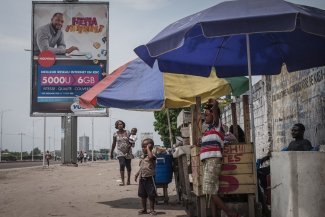The shocking death of a 25-year-old woman and her unborn baby in Harare this May after she was assaulted by bus touts sent shockwaves across Zimbabwe. It also once again highlighted the very serious problem of gender-based violence in the country.
Newly-married Lynn Tarisai Chidawaya (nee Amisi) was seven-months pregnant and travelling to South Africa by bus to buy baby clothes with her sister. At the bus terminal, they were approached by a number of touts who, while competing for their business, assaulted the women.
“They punched and assaulted us, and out of fear of further harm, we boarded their bus,” Lynn’s sister Liona told the Zimbabwean newspaper Newsday. On boarding the bus Lynn produced a blood clot and started vomiting. Within 48 hours both the mother and child were dead from abdominal trauma.
In a bitter irony, Chidawaya’s husband of just two months, Tinashe Chidawaya, works as a finance and administration officer for ActionAid Zimbabwe, an NGO that is a part of the global Safe Cities Campaign to make public spaces safer for women and girls.
“It is heart breaking to note that we have lost two precious lives due to unsafe public spaces at a time when Zimbabwe and the rest of the world are commemorating the Safe Cities Campaign one year on,” said ActionAid Zimbabwe country director Ronnie Murungu in a statement.
“In solidarity with our colleague, we unconditionally demand justice to be served and be an example to those who cause violence against women in the public spaces.”
Violence against women remains one of the greatest human rights violations, with Zimbabwe recording some of the highest levels in the Southern African Development Community (SADC) region according to the 2013 report Peace Begins at Home: Violence Against Women Baseline Study produced by Zimbabwe’s Ministry of Women Affairs, Gender and Community Development (MWAGCD), the southern African NGO Gender Links and the Zimbabwean NGO the Musasa Project.
The same study noted that 68 per cent of women in Zimbabwe – over two in three – report experiencing some form of violence in their lifetime, a trend attributed to tolerance of abuse in the country.
According to Murungu, there are a number of factors that contribute to the prevelance of violence against women in Zimbabwe, and underreporting is a massive issue.
“Socio-cultural norms and values as well as economic factors have often been blamed for the general reluctance by abused women to report their cases to the police or seek medical attention,” he tells Equal Times. “According to the baseline survey report, only one in every fourteen of physically abused women (7 per cent) reported violence to the police while one in thirteen (8 per cent) sought medical attention,” he said.
More violence in urban areas
Murungu said violence against women was more pronounced in urban and peri-urban areas as opposed to rural areas. In urban areas, women are labelled as ‘good ‘or ‘bad’ depending on the way they dressed. Those who are deemed to be improperly dressed are believed to be ‘deserving’ of the harassment.
“In Harare for instance, a girl was stripped of her clothes by touts as she was deemed to be indecently dressed and was left in her underwear only. From the baseline study conducted in January 2015 by ActionAid [editor’s note: a report titled Women and the City III: A Summary of Baseline Data on Women’s Experience of Violence in Seven Countries], some women indicated that they are even afraid to go for mass as they fear violence,” he said.
He said there were also insecurities related to urban poverty which made women vulnerable to violence, among them poor infrastructure, barriers to education and employment opportunities.
But Murungu said it is important to note that men are not only prepetrators of violence.
“Men play key roles in women’s urban safety. In studies carried out by ActionAid, men were identified as perpetrators, but also as potential allies,” he said.
However, he also warned that the historical discrimination and violent treatment of women frequently means that Zimbabwe’s private spaces are just as unsafe as public spaces.
“As such the dangers that women experience in public and private spaces are closely linked. For example, male control in the domestic arena can restrict women’s mobility in public spaces.”
He said there were very few policies and laws that directly protected women in urban spaces, with violence against women and their safety being normalised through social norms and attitudes.
“Social norms and attitudes permit – and even justify – disrespectful, discriminatory, and violent treatment toward women. Normalisation is reinforced through the impunity of perpetrators and lack of accountability of those who should provide protection,” he said, adding that in most cases women are themselves blamed for the violence and insecurity they experience.
Murungu also noted a lack of consistency in the way in which incidents of violence against women are reported and monitored, adding that the police offer inadequate protection for women. As such, it is difficult to inform policy and programmes given the serious lack of quality data.
Two-pronged approach
Murungu said ActionAid had taken a two-pronged approach to ensure safe cities with the programming side being carried out in the high density Harare township of Dzivarasekwa and the nearby town of Chitungwiza, in addition to the formation of a Safe Cities Campaign Network at both a local and national level to work along side various organisations and stakeholders.
“Women and girls in Dzivarasekwa through the Safe Cities campaign have been able to approach town councillors to erect tower lights in areas where some had malfunctioned. As a result women are now free to move without fear of violence in these areas where prior to the campaign they succumbed to robbery and rape at these dark spots,” he said.
He said they had also engaged in a campaign targeting commuter transport operators sensitising them on the need to reduce the harassment of and violence against women at their ranks and in their vehicles.
Zimbabwe Congress of Trade Unions (ZCTU) gender coordinator Fiona Magaya told Equal Times that harassment and violence against women at the workplace was also rampant, prompting the labour body to initiate a number of workplace-based programmes to empower women and also to advocate for gender policies at the workplace.
“The ZCTU has launched a campaign against gender-based violence and is currently doing workplace sensitisation and a ‘training of trainers’ workshops. The gender department is also handling a number of workplace-based gender violence cases and referring some of the cases for prosecution and counselling through organisations that deal with GBV,” she said.
Magaya said they were also working with the Zimbabwe police force to ensure protection orders are issued to abused women and their safety is ensured, adding that gendered violence is a serious hindrance to gender equality at work.









